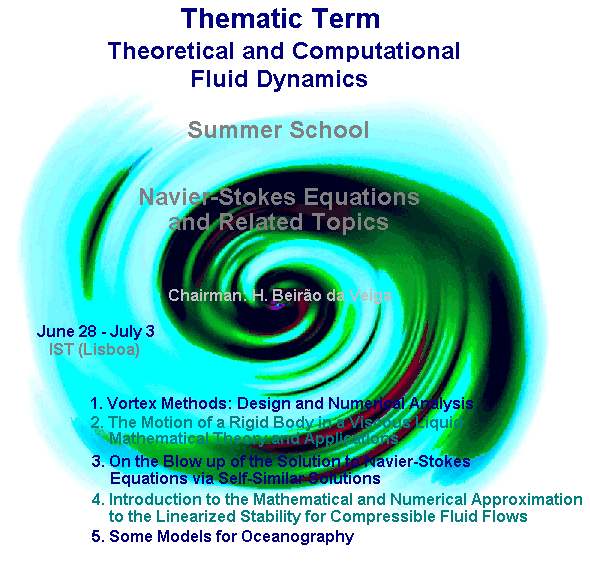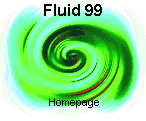 |
 |
The self-similar solutions, if non-trivial, produce a blow up,
as it was proposed by J.Leray in his famous paper in 1934. We shall
present several results showing the non-existence of a non-trivial
backward self-similar solution for the Cauchy problem. All those
results are strongly based on the maximum principle for a special
form of the combination of kinetic energy, pressure and momentum
of the speed.
Surprisingly, a completely other method, developed for the construction
of a non-trivial solution in the half-space will be shown to
give the same result.
The problem of the motion of a rigid body through a liquid has attracted
the attention of several scientists over a century ago. Actually, the
first systematic study was initiated by Kirchhoff and Lord
Kelvin in the second half of nineteenth century, in the case when the
liquid is frictionless. The main feature of this type of problems relies
in the fact that the mechanical system is constituted by the solid and
the liquid, so that the motion of the one influences that of the
other and vice versa. Typical examples are, for instance, the steady fall
of a body in a viscous liquid under the action of gravity, or the
selfpropulsion of a micro-organism in an organic suspension. From the
mathematical viewpoint, these problems find their natural formulation in
the framework of exterior problems. The interesting issue, however,
is that here the equations governing the motion of the body are coupled
with those of the liquid. This should be contrasted with the "classical"
exterior problem, where the motion of the body is prescribed.
The objective of these lectures is to give an introductory course on the
above subject, with special emphasis to the case when the liquid is either
an incompressible Navier-Stokes fluid or is a second-order approximation
of a viscoelastic incompressible fluid. In particular, we shall formulate
existence and uniqueness results for initial-boundary as well as
boundary-value problems. These results will then be applied to the problem
of particle sedimentation and to selfpropulsion of ciliated
organisms. We shall also analyze the stability of steady solutions
and compare our results with experiments.
The goal of these lectures is to give an overview of vortex methods
with emphasis on some recent developments which make them viable alternative to
more comventional methods for Direct Numerical Simulations or Large Eddy
Simulations of incompressible flows.
The lessons will follow the outline of a book written with P.
Koumoutsakos which is coming out in 1999 at Cambridge University Press
and will be illustrated with a number of numerical simulations.
Lecture 1:
Stability of flows is a classical problem in Fluid Mechanics. If we neglect
dissipative phenomena (viscosity, heat conduction,...), most of fluid flows
can be modeled by means of a nonlinear hyperbolic system of conservation
laws. We are thus faced to study the stability of the solutions of these
nonlinear systems. Given such a solution, called basic solution, the first
step consists in studying its linearized stability, i.e., the behavior in
time of solutions of the linearized hyperbolic system obtained by
linearizing the system of conservation laws at the basic solution. The
course is a mathematical introduction to the linearized stability of
solutions of nonlinear hyperbolic systems with applications to compressible
fluid flows.
The plan of the course is as follows.
1) The problem of linearized stability; the linearized hyperbolic
systems;the case of discontinuous basic solutions.
The lectures will be concerned with various questions which arise when
modeling fluid flows in Oceanography: which variants of Navier-Stokes
equation should one consider, which boundary conditions should one use,
are examples of these questions.

Navier-Stokes Equations
Chairman: H. Beirão da Veiga
and Related Topics________

Centro de Matemática Aplicada
Instituto Superior Técnico
June 28 - July 3, Lisbon (Portugal)
J. Necas (Charles University, Prague, Czech Republic, and North. Illinois Univ., U.S.A.)
G. P. Galdi (Univ. Pittsburgh, U.S.A.)
G. H. Cottet (LMC, Univ. Grenoble I, France)
P. A. Raviart (CMAP, Ecole Polytechnique, France)
L. Tartar (Carnegie Mellon Univ., Pittsburgh, U.S.A.)

On the Blow Up of the Solutions to the Navier-Stokes
Equations via Self-Similar Solutions
J. Necas
(Charles University, Prague, Czech Republic
and North. Illinois Univ., U. S. A.)

The Motion of a Rigid Body in a Viscous Liquid: Mathematical Theory and Applications
G. P. Galdi
(University of Pittsburgh, U.S.A.)

Vortex Methods: Design and Numerical Analysis.
G.-H. Cottet
(LMC, Univ. Grenoble I, France)
We present the basic definitions of vortex methods in 2D. We
show their conservation properties and illustrate their main features on
vortex sheet caluclations.
Lecture 2:
We describe the various 3D algorithms (vortex filament and
vortex particle methods), and the available viscous schemes (random walk
and deterministic methods).
Lecture 3:
We outline the numerical analysis of vortex methods. The
analysis is based on
the notion of weak solutions to transport equations and error estimates
are derived in distribution spaces.
Lecture 4:
We focus here on boundary conditions. we in particular
describe vorticity boundary conditions for viscous flows and their links
with vorticity creation algorithms.
Lecture 5:
We present here some developpments of vortex methods towards
domain decomposition and hybrid particle-grid techniques. We also show
the particular role played by vortex methods in the context of Large Eddy simulations.

Introduction to the Mathematical and Numerical Approximation
to the Linearized Stability for Compressible Fluid Flows
P. A. Raviart
(Ecole Polytechnique, France)
2) Application to the Euler equations of compressible gas dynamics; the
Rayleigh-Taylor and Kelvin-Helmholtz instabilities; the Riemann problem and
the Richtmyer-Meshkov instability.
3) The case of high frequency perturbations : the W.K.B. method.
4) A general numerical approach for the linearized stability.

Some Models in Oceanography
L. Tartar
(Carnegie Mellon Univ., Pittsburgh, U.S.A.)